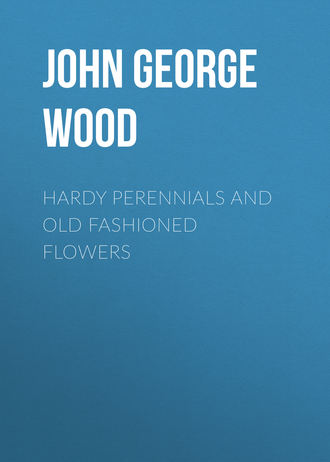 полная версия
полная версияHardy Perennials and Old Fashioned Flowers
Flowering period, May and June.
Anemone Vernalis
Shaggy Windflower; Nat. Ord. RanunculaceæA curious but pretty alpine species, from the Swiss Alps, consequently very hardy. It is not a showy subject, but its distinctions are really beautiful, and commend it to those who love to grow plants of a recherché character.
The illustration (Fig. 12) will give some idea of it, but no description can convey even an approximate notion of its flowers, which are produced singly, on short, stout, hairy stems, about 5in. high. For so small a plant the flower is large, more than an inch across when expanded, but usually it keeps of a roundish, bell-shaped form. Its colour is a bluish-white inside, the outside being much darker. It would be violet, were not the hairs so long and numerous that they form a brownish coat which is, perhaps, the most remarkable trait of this species. The leaves, too, are very hairy—twice, and sometimes thrice, divided, rather small, and also few.
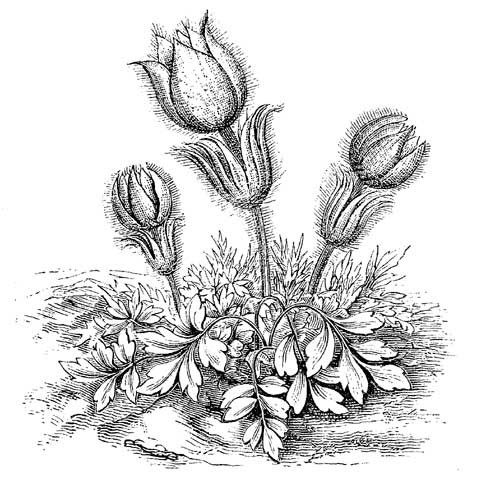
Fig. 12. Anemone Vernalis (Shaggy Anemone).
(One-half natural size.)
This little plant is most enjoyed when grown in pots. It may be plunged in sand or ashes in an open space, but it should never be allowed to suffer for moisture. When so grown, and just before the flowers open, it should be removed to a cool, airy frame, where it should also be plunged to keep its roots cool and moist; it will require to be very near the glass, so as to get perfect flowers. Such a method of growing this flower affords the best opportunity for its close examination; besides, it is so preserved in finer and more enduring form. It thrives well in lumpy peat and loam, but I have found charcoal, in very small lumps, to improve it, as it does most plants grown in pots, especially such as require frequent supplies of water. The slugs are very fond of it; a look-out for them should be kept when the plants are growing, and frequent sprinklings of sharp ashes will be found useful.
Flowering period, April and May.
Anthericum Liliago
St. Bernard's Lily; Nat. Ord. LiliaceæThis may be grown as a companion to St. Bruno's Lily, though not so neat in habit or rich in bloom. In all respects it is very different. It is taller, the flowers not half the size, and more star-shaped, foliage more grassy, and the roots creeping and jointed.
All the Anthericums named by me will do in ordinary soil, but prefer a fat loam of considerable depth. If, therefore, such conditions do not exist, there should be a good dressing of well-rotted stable manure turned in, and a mulching given in early spring.
Anthericums are propagated by division of the roots, which should be carefully performed during the autumn. After such mutilation they should not be disturbed again for three years, or they will deteriorate in vigour and beauty.
Flowering period, June and July.
Anthericum Liliastrum
St. Bruno's Lily; Nat. Ord. LiliaceæThis charming plant is a native of Alpine meadows, and is known by other names, as Paradisia and Cyackia, but is more commonly called St. Bruno's Lily. It is emphatically one of the most useful and handsome flowers that can be grown in English gardens, where, as yet, it is anything but as plentiful as it ought to be. Not only is it perfectly hardy in our climate, but it seems to thrive and flower abundantly. It is fast becoming a favourite, and it is probable that before long it will be very common, from the facts, firstly, of its own value and beauty, and, secondly, because the Dutch bulb-growers have taken it in hand. Not long ago they were said to be buying stock wherever they could find it. The illustration (Fig. 13) shows it in a small-sized clump. Three or four such specimens are very effective when grown near together; the satin-like or shining pure white flowers show to greater advantage when there is plenty of foliage. A number planted in strong single roots, but near together, forming a clump several feet in diameter, represent also a good style; but a single massive specimen, with at least fifty crowns, and nearly as many spikes of bloom just beginning to unfold, is one of the most lovely objects in my own garden.
The chaste flowers are 2in. long, six sepalled, lily-shaped, of a transparent whiteness, and sweetly perfumed; filaments white, and long as the sepals; anthers large, and thickly furnished with bright orange-yellow pollen; the stems are round, stout, 18in. high, and produce from six to twelve flowers, two or three of which are open at one and the same time. The leaves are long, thick, with membranous sheaths, alternate and stem-clasping, or semi-cylindrical; the upper parts are lanceolate, dilated, subulate, and of a pale green colour. The roots are long, fleshy, brittle, and fasciculate.
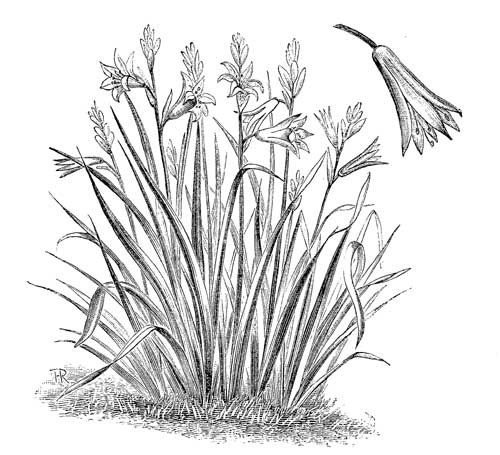
Fig. 13. Anthericum Liliastrum.
(One-sixth natural size); blossom, one-fourth natural size.)
This plant for three or four weeks is one of the most decorative; no matter whether in partial shade or full sunshine, it not only flowers well, but adorns its situation most richly; the flowers, in a cut state, are amongst the most useful and effective of hardy kinds—indeed, they vie with the tender exotics.
Flowering period, June and July.
A. l. major is a new variety in all its parts like the type, with the exception of size, the flowers being larger by nearly an inch. The variety is said to grow to the height of 8ft.
Anthyllis Montana
Mountain Kidney Vetch; Nat. Ord. LeguminosæFor rockwork this is one of the most lovely subjects. It is seldom seen, though easy to grow, perfectly hardy, and perennial. It is classed as an herbaceous plant, but it is shrubby, and on old specimens there is more wood than on many dwarf shrubs. It is of a procumbent habit, and only 4in. to 6in. high in this climate. It comes from the South of Europe, where it probably grows larger.
In early spring the woody tips begin to send out the hoary leaves; they are 3in. to 6in. long, and from their dense habit, and the way in which they intersect each other, they present a pleasing and distinct mass of woolly foliage.
The leaves are pinnatifid, leaflets numerous, oval, oblong, and very grey, nearly white, with long silky hairs.
The flowers are of a purple-pink colour, very small, and in close drumstick-like heads. The long and numerous hairs of the involucre and calyx almost cover over the flowers and render them inconspicuous; still, they are a pretty feature of the plant; the bloom stands well above the foliage on very downy, but otherwise naked stalks.
When planted in such a position that it can rest on the edge of or droop over a stone, strong specimens are very effective. It seems to enjoy soil of a vegetable character, with its roots near large stones. I have heard that it has been found difficult to grow, but that I cannot understand. I fear the fault has been in having badly-rooted plants to start with, as cuttings are very slow in making an ample set of roots for safe transplanting. Its increase by division is no easy matter, as the woody stems are all joined in one, and the roots are of a tap character. Seed seldom ripens; by cuttings appears to be the readier mode of propagation; if these are taken off in early spring, put in a shady position, and in leaf soil, they will probably root as the seasons get warmer.
Flowering period, June and July.
Apios Tuberosa
Syn. Glycine Apios; Nat. Ord. LeguminosæThis is a pretty climber, or, more strictly speaking, a twiner; it is hardy, tuberous, and perennial. The tubers resemble potatoes, but incline to pear-shape, as implied by the generic name. 240 years ago it was introduced from North America; still, it is seldom met with, notwithstanding its good habit and colour. It is one of those happy subjects which most conduce to the freshness and wild beauty of our gardens; the dark and glossy verdure is charmingly disposed in embowerments by means of the delicate twining stems; and though it grows apace, there is never an unsightly dense or dark mass, so commonly seen in many climbers, but, instead, it elegantly adorns its station, and the outlines of its pretty pinnate leaves may easily be traced against the light.
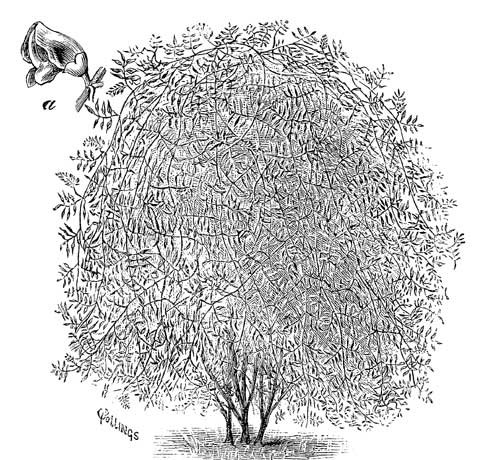
Fig. 14. Apios Tuberosa.
(One-twelfth natural size; a, flower, natural size.)
As may be seen by the illustration (Fig. 14), it is in the way of a climbing bean. The flowers are purple and borne in small clusters from the axils of the leaves, and, of course, as indicated by the order to which it belongs, they are like pea flowers; they are produced a long time in succession, providing the frosts do not occur; they have the scent of violets. The leaves are distantly produced on fine wiry stems, which grow to the length of 12ft.; they are pinnate, the leaflets being of various sizes, oval, smooth, and of a dark shining green colour.
The roots are not only peculiar in the way already mentioned, but the tubers have the appearance of being strung together by their ends. They are edible, and where they grow wild they are called "ground nuts." From the description given it will be easy to decide how and where it should be planted.
There should be provision made for its twining habit, and it may have the liberty of mixing its foliage with that of less beautiful things during autumn, such, for instance, as the bare Jasmine nudiflora; its spare but effective leaves and flowers will do little or no harm to such trees, and after the frosts come the jasmine will be clear again. It may also be grown with happy results as shown in the illustration, needing only a well-secured twiggy bush. Cut as sprays it is very serviceable for hanging or twining purposes.
It most enjoys a light soil, also a sunny situation. Sometimes it has been found slow at starting into growth when newly planted; this, however, can hardly be the case with newly lifted tubers. I may add that it is no uncommon thing for these to be out of the ground for weeks and months together, when they not only become hard and woody, but when suddenly brought in contact with the damp earth rot overtakes them. There is no difficulty whatever with fresh tubers, which may be lifted after the tops have died off. Beyond securing fresh roots, there is nothing special about the culture of this desirable climber.
Flowering period, August to October.
Arabis Lucida
Shining Rock Cress; Nat. Ord. CruciferæThis member of a well-known family of early spring flowers is desirable, for its neat habit and verdancy. There is not a particle of sere foliage to be seen, and it has, moreover, a glossy appearance, whence the specific name. The flowers are not of much effect, though, from their earliness, not without value; they are in the way of the flowers of the more common species, A. alpina, but less in size; they are also more straggling in the raceme; these two features render it inferior as a flower; the stalks are 3in. to 6in. high. The leaves are arranged in lax flattened rosettes, are 1in. to 3in. long, somewhat spathulate, notched, fleshy, of a very dark green colour, and shining. The habit is dense and spreading, established tufts having a fresh effect. Though an Hungarian species, it can hardly have a more happy home in its habitat than in our climate. Where verdant dwarf subjects are in request, either for edgings, borders, or rockwork, this is to be commended as one of the most reliable, both for effect and vigour. In the last-named situation it proves useful all the year round, but care should be taken that it does not overgrow less rampant rock plants.
A. l. variegata is a variety with finely-marked leaves. The bloom resembles that of the type, but is rather weaker. It is better to remove the flowers of this kind, as then the rather slow habit of growth is much improved, as also is the colour of the foliage. The leaves being more serviceable and effective than the bloom, the uses should be made of it accordingly. They are broadly edged with yellow, the green being lighter than that of the type, but equally bright; the ends of the leaves are curled backwards, but, with the exception of being a little smaller, they are similar in shape to the parent form. This is a gem for rockwork, and, if it did not belong to a rather ordinary race of plants, it would, perhaps, be more often seen in choice collections. This, however, does not alter its worth. Seen in crevices of dark stone on rockwork, or in bold tufts near the walks, or planted with judgment near other dwarf foliaged subjects, it ever proves attractive. It is much less rampant, and, perhaps, less hardy than the type. It has only been during the recent very severe winters, however, that it has been killed. The Arabis is easily propagated by slips or rootlets, which should be taken after flowering. The variegated form is better for being so propagated every year. If bold patches are desired, they should be formed by planting a number together, 3in. or 4in. apart.
Flowering period, February to June.
Aralia Sieboldi
Siebold's Aralia; Nat. Ord. AraliaceæThe present subject (see Fig. 15)—beautiful, hardy, and evergreen—is a species of recent introduction; still, it has already become well known and distributed, so much so that it scarcely needs description; but there are facts in reference to it which would seem to be less known. It is seldom seen in the open garden, and many amateurs, who otherwise are well acquainted with it, when they see it fresh and glossy in the open garden in the earliest months of the year, ask, "Is it really hardy?" Not only is such the case, but the foliage, and especially the deep green colour, are rarely so fine when the specimens have indoor treatment, and, on this account, the shrub is eminently suitable for notice here.
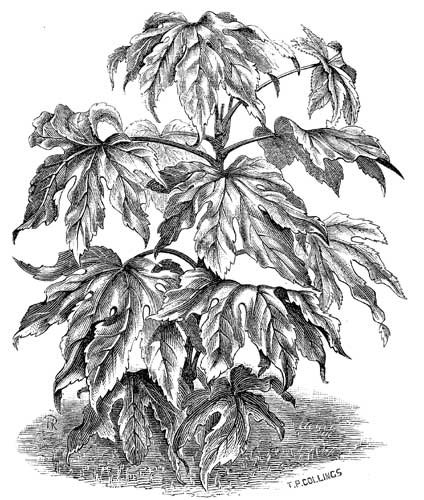
Fig. 15. Aralia Sieboldi.
(One-tenth natural size.)
The order Araliaceæ is nearly related to Umbelliferæ, from which fact an idea may be had of the kind and arrangement of the flowers. Many of the genera of the order Araliaceæ are little known; perhaps the genus Hedera (ivy) is the only one that is popular, and it so happens to immediately follow the genus Aralia. To remember this will further assist in gleaning an idea of the form of blossom, as that of ivy is well known. Aralia Sieboldi, however, seldom flowers in this climate, either in or out of doors. When it does, the white flowers are not of much value; they are small, like ivy blossom in form, but more spread in the arrangement. There are five sepals, five petals, five styles, and five cells in the berries. The flowers are produced on specimens 2ft. to 5ft. high during winter, when favourable. The leaves, when well grown, are the main feature of the shrub, and are 12in. or more across. This size is not usual, but a leaf now before me, and taken from an outside specimen, measures over a foot, with a stout round stalk, 13in. long; the form of leaf is fan-shaped, having generally seven lobes, each supported by a strong mid-rib; the lobes are formed by divisions rather more than half the diameter of the leaf; they are slightly distant, broadly lance-shaped, waved at the edges, toothed near the ends, the teeth being somewhat spiny; the substance is very stout and leather-like to the touch; the upper surface is a dark shining bronzy-green, beautifully netted or veined; the under surface is a pale green, and richly ornamented by the risen mid-ribs and nerves of the whole leaf; the leaf-stalks are thick, round, bending downwards, and 6in. to 18in. long, springing from the half woody stem.
The habit of the shrub is bushy, somewhat spreading, causing the specimens to have a fine effect from their roundness, the leaf arrangement also being perfect. Without doubt this is one of the most distinct and charming evergreens for the ornamental garden, sub-tropical in appearance, and only inferior to palms as regards size; it is effective anywhere. It need not be stated that as a vase or table decoration it ranks with the best for effect and service, as it is already well-known as such. In planting this subject outside, young but well-rooted examples should be selected and gradually hardened off. At the latter end of May they should be turned out of the pots into a rich but sandy loam. The position should be sunny, and sheltered from the north. Some have advised that it should be grown under trees, but I have proved that when so treated the less ripened foliage has suffered with frost, whilst the specimens fully exposed to the sun have not suffered in the least; they would droop and shrivel as long as the frost remained, but as soon as the temperature rose they became normal, without a trace of injury. When planted as above, young specimens will soon become so established and inured to open-air conditions, that little concern need be felt as regards winter; even such as were under trees, where they continued to grow too long, and whose tender tops were cut away by frost, have, the following summer, made a number of fresh growths lower down the stems. I should like to say that on rockwork this shrub has a superb effect, and I imagine the better drained condition of such a structure is greatly in favour of its health and hardiness. The propagation is by means of cuttings; slips of half-ripened wood, taken during the warmest months, if put in sandy loam in a cucumber frame, will root like willow. As soon as roots have formed, pot them separately and plunge the pots in the same frame for a week or two, then harden off. For the first winter the young stock ought to be kept either in a greenhouse or a cold frame, and by the end of the following May they will be ready to plant out. A well-drained position is important.
Flowering period, November to March, in favourable or mild seasons.
Arisæma Triphyllum
Syns. A. Zebrinum and Arum Triphyllum; Common Names, Three-leaved Arum and Jack-in-the-Pulpit; Nat. Ord. AraceæA hardy tuberous-rooted perennial from North America. I will at once explain that the above leading name is not the one generally used here, but in America, where the species is common, botanists have adopted it; besides, it is, as will be seen from the following description, very distinct from other Arums. The Syn. Arisæma zebrinum, as given, belongs really to a variety of A. triphyllum, but the type is marked in its flowers zebra-like, and there are many shades and colours of it, therefore both or either of the names may be used for the different forms, with a fair degree of propriety, as in fact they are.
There is a doubt with some as to the hardiness of this plant; in my mind there is none whatever. It is no stranger to frosts in its habitats, but I do not found my conviction on anything but my experience of it. It has been grown fully exposed for two winters, and sometimes the frosts must have gone as far down as the roots.
There is nothing showy about this plant, but there is something which stamps it as a fitting subject for a garden of choice plants; its bold, dark green foliage and quaint-looking flowers render it desirable on the score of distinctness. It has, moreover, a freshness upon which the eye can always linger. The flowers are in general form like the calla-lily; the upper part of the spathe, or sheathing leaf, which is really the calyx, is, however, more elongated, pointed, and hooked; otherwise the spathe is erect, slightly reflexed just above the folded part, giving the appearance of a pair of small lobes; this—the calyx—is really the most conspicuous part of the flower; in the belly it is beautifully striped with broad lines of a purplish-brown colour, which shade off to an inch of green in the middle, when they form again, and continue to the tip of the spathe, which will be 4in. to 6in. long, and nearly 2in. broad at the widest part; these lines run between the ribs, and, as before hinted, they are of various colours, such as brown, purple, pink, and green. The ribs are nearly white, and the green parts are very pale. The spadix is over 3in. long, club-shaped, spotted with brown, very much so near the end. The anthers at the base of the spadix are curious, and should be examined. They are invisible until the folded part of the spathe is opened; they are numerous, arranged in a dense broad ring, sessile, and nearly black. This curious flower is produced on a stout, round scape, a foot or more in height. The leaves are radical, having a stalk a foot long. They are, as the specific name implies, divided into three parts, each being of equal length, entire, wavy, and pointed. The whole plant has a somewhat top-heavy appearance (see Fig. 16), but I never saw it broken down by the weather. It makes quick growth in spring, the scape appearing with the leaves; in late summer it dies down. It looks well in quiet nooks, but it also forms a good companion to showy flowers in more open situations; in a cut state, for dressing "old-fashioned" vases, nothing could be in better character, a few leaves of yarrow, day lily, flag, or similar foliage being all it will require.
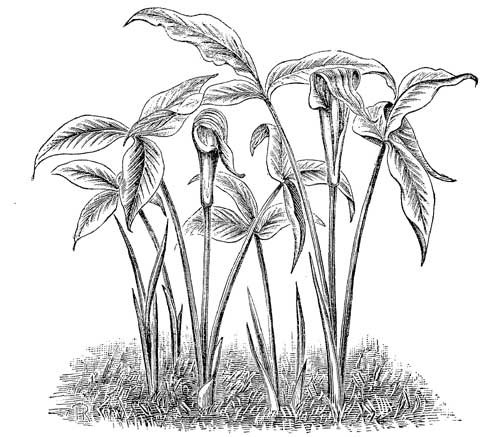
Fig. 16. Arisæma Triphyllum.
(One-fourth natural size.)
It may be transplanted, any time from September to the end of January, into good light loam or leaf soil, 4in. or 6in. deep; if there should be a dry season during the period of growth, the plant should be well watered. To increase it, the tubers may be divided every third year, providing the growth has been of a vigorous tone. I may add, that, from its tall and not over-dense habit, there may with advantage, both to it and the plants used, be a carpet grown underneath—ivy, vincas, or sweet woodruff for some situations, and brighter subjects for more conspicuous parts of the garden, such as the finer kinds of mimulus, ourisia, alpine aster, and dwarf iris.
Flowering period, June and July.
Arum Crinitum
Hairy Arum, or Dragon's Mouth; Nat. Ord. AraceæAs may be seen by the illustration (Fig. 17), this is a most singular plant. It proves hardy in this climate if its position is selected; in other words, it is not hardy in all kinds of soils and situations, but if planted four or five inches deep, in sandy or half decayed vegetable mould, facing the south, there is little to fear either as regards hardiness or its thriving. I think, therefore, it may be called hardy. It is far more interesting than handsome, but there is at the present time an evident desire amongst amateurs to grow the various Arums, and more especially has this one been sought after; I have, therefore, introduced it amongst more beautiful flowers, and given an enlarged drawing of the entire plant, together with the spathe in its unopened state.
The plant is a native of Minorca, and was imported in 1777. In this climate it grows to the height of 18in., developing the flower with the foliage. It is produced on a stout scape nearly 1ft. high, of a pale green colour, marked with dark short lines and spotted with delicate pink dots. The folded spathe is of leather-like substance, rough, almost corky in texture; also variously marked and tinted. At the base there are a number of green lines arranged evenly and longitudinally on a nearly white ground. A little higher—the belly part—the lines are less frequent, irregular, and mixed with pink dots. Still higher, the ground colour becomes pale green, the lines dark green, and the pink spots are changed to clouded tints; the remainder of the folded spathe—to the tip—is a mixture of brown and green dots, the total length being fully 9in. When the spathe opens, it does so quickly, bending more than half its length outwards, the division looking upwards. To those who have not before seen the plant at this stage, it will prove an interesting surprise; the odour, however, is repulsive. The spathe at its widest part is 6in. broad, and tapers off to a blunt point. It is of a dark purple colour and covered with long bent dark hairs, whence the specific name. They are curiously disposed, and remind one of some hairy animal that has been lifted out of the water the wrong way as regards the direction of the hair. The spadix is comparatively small, black, and also covered with hairs. The flower should be closely watched if its peculiarities are to be fully noted, as it not only opens quickly but soon begins to wither. During the short period that the flower is open the lower part of the spathe or belly becomes filled with all kinds of flies, being held by the spear-like hairs.








